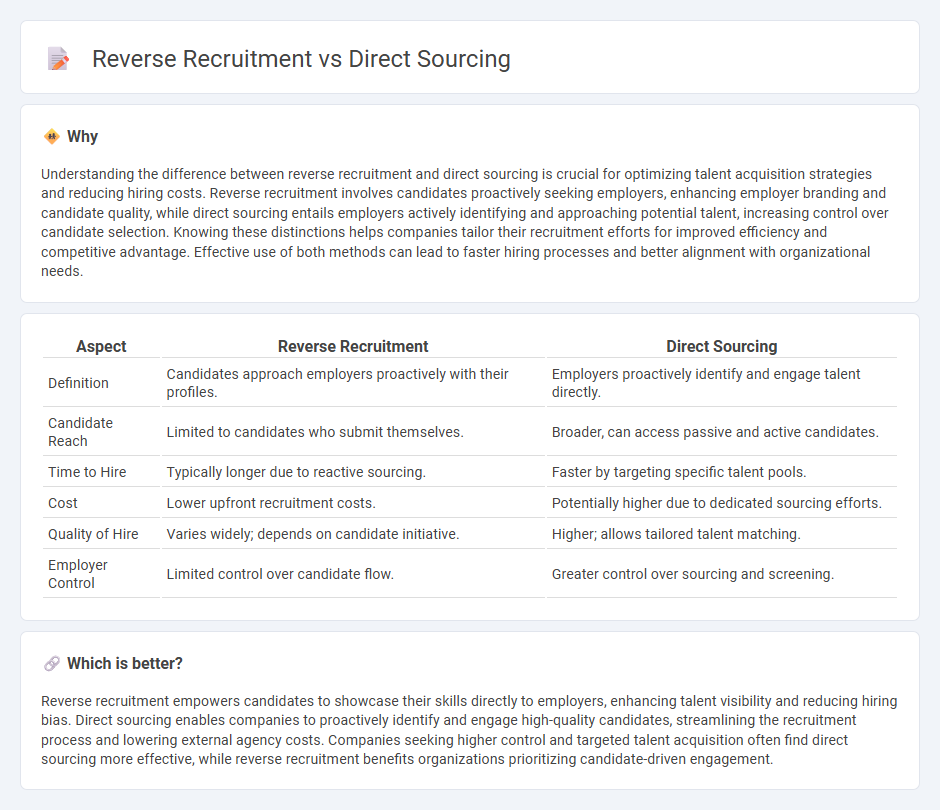
Reverse recruitment empowers candidates by allowing them to showcase their skills directly to employers, transforming the traditional hiring dynamic. Direct sourcing streamlines talent acquisition by enabling companies to proactively identify and engage qualified candidates without intermediaries. Explore the differences and benefits of each approach to optimize your hiring strategy.
Why it is important
Understanding the difference between reverse recruitment and direct sourcing is crucial for optimizing talent acquisition strategies and reducing hiring costs. Reverse recruitment involves candidates proactively seeking employers, enhancing employer branding and candidate quality, while direct sourcing entails employers actively identifying and approaching potential talent, increasing control over candidate selection. Knowing these distinctions helps companies tailor their recruitment efforts for improved efficiency and competitive advantage. Effective use of both methods can lead to faster hiring processes and better alignment with organizational needs.
Comparison Table
| Aspect | Reverse Recruitment | Direct Sourcing |
|---|---|---|
| Definition | Candidates approach employers proactively with their profiles. | Employers proactively identify and engage talent directly. |
| Candidate Reach | Limited to candidates who submit themselves. | Broader, can access passive and active candidates. |
| Time to Hire | Typically longer due to reactive sourcing. | Faster by targeting specific talent pools. |
| Cost | Lower upfront recruitment costs. | Potentially higher due to dedicated sourcing efforts. |
| Quality of Hire | Varies widely; depends on candidate initiative. | Higher; allows tailored talent matching. |
| Employer Control | Limited control over candidate flow. | Greater control over sourcing and screening. |
Which is better?
Reverse recruitment empowers candidates to showcase their skills directly to employers, enhancing talent visibility and reducing hiring bias. Direct sourcing enables companies to proactively identify and engage high-quality candidates, streamlining the recruitment process and lowering external agency costs. Companies seeking higher control and targeted talent acquisition often find direct sourcing more effective, while reverse recruitment benefits organizations prioritizing candidate-driven engagement.
Connection
Reverse recruitment empowers candidates to proactively showcase their skills and preferences to employers, creating a talent pool that organizations can access directly. Direct sourcing leverages this approach by enabling companies to identify and engage qualified candidates without intermediaries, reducing time-to-hire and recruitment costs. Both strategies prioritize efficiency and enhance the alignment between employer needs and candidate capabilities in the employment landscape.
Key Terms
Talent Pool
Direct sourcing builds a proactive talent pool by engaging candidates through employer branding, social media, and internal databases, ensuring faster access to high-quality talent. Reverse recruitment emphasizes leveraging external recruiters to tap into their networks and talent pools, improving candidate diversity and specialized skill acquisition. Discover how integrating these strategies can optimize your talent acquisition process.
Candidate Outreach
Direct sourcing emphasizes proactive candidate outreach by leveraging internal resources and talent pools to identify potential hires efficiently. Reverse recruitment shifts the focus towards attracting candidates by promoting employer brand and creating compelling talent experiences that encourage applications. Explore detailed strategies to maximize candidate engagement in both approaches.
Employer Branding
Direct sourcing leverages proactive talent identification and engagement to enhance employer branding by showcasing a company's commitment to nurturing relationships and valuing candidate experience. Reverse recruitment flips the traditional hiring process by encouraging candidates to find and apply to roles aligned with their skills, reinforcing an authentic brand image based on transparency and candidate empowerment. Explore how these strategies can elevate your employer brand and attract top talent effectively.
Source and External Links
What Is Direct Sourcing? How to Start Recruiting Top Talent - Direct sourcing is the practice of identifying and hiring candidates for open roles using a company's internal resources instead of relying on third-party staffing agencies, helping save costs and improve quality control while quickly building a pool of pre-qualified talent.
What is direct sourcing | Randstad Enterprise - Direct sourcing, also known as direct fulfillment, allows companies to acquire contingent talent by minimizing third-party involvement, often using branded talent pools, resulting in closer relationships, cost savings, and more agile deployment of flexible workers.
What is Direct Sourcing? Definition Explained | GEP Glossary - In procurement, direct sourcing refers to the in-house purchase of raw materials, goods, or services essential to a business's core operations that become part of the final product, differentiating it from indirect sourcing used for non-core items.
 dowidth.com
dowidth.com